Ford Fiesta workshop manual
The Ford Fiesta is a supermini automobile produced by the Ford Motor Company from 1976 with present.In 2010, the sixth-generation Fiesta had been introduced worldwide, including inside the United States plus Canada, generating it the initially Fiesta model with be
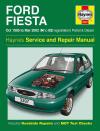
Get other Ford repair manuals hereFord Fiesta Petrol and Diesel 1995 - 2002 Haynes Owners Service Repair Manual covers models: Hatchback Van Courier and Combi Including Special/Limited Editions.Petrol Engines: 1.25 litre (1242cc) 1.3 litre (1298cc) 1.4 litre (1388cc) 1.6 litre (1596cc)Diesel Engines: 1.8 litre (1753cc) inc. turbo.Inside this manual you will find: Routine Maintenance tune-up procedures engine repair cooling and heating air-conditioning fuel and exhaust emissions control ignition brakes suspension and steering electrical systems and wiring diagrams.Haynes repair manuals can save you money on maintenance and repair bills. Step-by-step procedures and illustrations guide you through every job from basic maintenance and troubleshooting to complete teardown rebuild.Information on Repair and Service ManualsNote that repair manuals are normally produced for models sold in a particular country.Differences in specification can exist between models sold in different countries and it
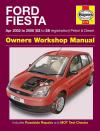
Ford Fiesta 2002 - 2008 petrol and diesel workshop repair manual NEW Get other Ford repair manuals hereFord Fiesta Petrol Diesel 2002 - 2008 Haynes Owners Workshop Manual English workshop manual covering WP series Fiesta sold in Australia from April 2004. This manual includes information on the Duratec 1.6 L engine as sold in Aust models as well as the engines offered in the Fiesta (and related Fusion) in the European market: 1.25 L 4 cylinder Duratec petrol1.3 L 4 cylinder Duratec petrol1.4 L 4 cylinder Duratec petrol1.6 L 4 cylinder Duratec petrol as seen in Aust market Fiestas1.4 L 4 cylinder TDCi Duratorq turbo diesel1.6 L 4 cylinder TDCi Duratorq turbo diesel Does NOT cover the 2.0 L Fiesta ST (XR4 in Aust) or new Fiesta range introduced for 2009 model year Transmissions described are: iB5 5-speed manualDurashift EST 5-speed automaticNOTE: Only maintenance adjustment minor repair procedures plus removal and instal
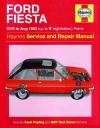
Get other Ford repair manuals hereFord Fiesta 1976 - 1983 manual covers: Hatchback including special/limited editions 1976 - 1983 1.0 litre (957cc) 1.1 litre (1117cc) 1.3 litre (1298cc) and 1.6 litre (1598cc)Inside this manual you will find: Routine Maintenance tune-up procedures engine repair cooling and heating air-conditioning fuel and exhaust emissions control ignition brakes suspension and steering electrical systems and wiring diagrams.Haynes repair manuals can save you money on maintenance and repair bills. Step-by-step procedures and illustrations guide you through every job from basic maintenance and troubleshooting to complete teardown rebuild.Information on Repair and Service ManualsNote that repair manuals are normally produced for models sold in a particular country.Differences in specification can exist between models sold in different countries and items such as installed engines can differ.Please check that the manual will cover your model before purchase and if you need more detail please contact us here..
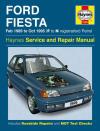
Get other Ford repair manuals hereFord Fiesta Petrol 1989 - 1995 Haynes Owners Service Repair Manual covers models: Hatchback Van and Courier Including XR2i RS Turbo RS 1800 Classic (to 1997) CTX (automatic) transmission and Special/Limited Editions.Engines Covered:1.0 litre (999cc) 1.1 litre (1118cc) 1.3 litre (1297cc) 1.4 litre (1392cc) 1.6 litre (1596 and 1597cc) and 1.8 litre (1796cc).Inside this manual you will find: Routine Maintenance tune-up procedures engine repair cooling and heating air-conditioning fuel and exhaust emissions control ignition brakes suspension and steering electrical systems and wiring diagrams.Haynes repair manuals can save you money on maintenance and repair bills. Step-by-step procedures and illustrations guide you through every job from basic maintenance and troubleshooting to complete teardown rebuild.Information on Repair and Service ManualsNote that repair manuals are normally produced for models sold in a particular country.Differences in specification can exist between models
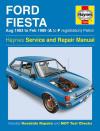
Get other Ford repair manuals hereFord Fiesta Petrol 1983 - 1989 A to F manual covers: Hatchback and Van with manual transmission Including Special/Limited Editions 1983 - 1989 A to F 1.0 litre (957cc) 1.1 litre (1117cc) 1.3 litre (1296cc) 1.4 litre (1392cc) and 1.6 litre (1597cc).Inside this manual you will find: Routine Maintenance tune-up procedures engine repair cooling and heating air-conditioning fuel and exhaust emissions control ignition brakes suspension and steering electrical systems and wiring diagrams.Haynes repair manuals can save you money on maintenance and repair bills. Step-by-step procedures and illustrations guide you through every job from basic maintenance and troubleshooting to complete teardown rebuild.Information on Repair and Service ManualsN
.png)
Ford Fiesta Petrol Diesel 2008 - 2011 Haynes Owners Service Repair Manual covers Hatchback.Petrol Engines Covered: 1.25 litre (1242cc) Zetec-SE 1.4 litre (1388cc) Zetec-SE 1.6 litre (1596cc) Zetec-SEDiesel Engines Covered: 1.4 litre (1399cc)Duratorq DLD-414 1.6 litre (1560cc)Duratorq DLD-416Contents: Living with Your Ford Fiesta Roadside Repairs Weekly Checks Lubricants Fluids Tyre Pressures Routine Maintenance Service Petrol Engine In-Car Repair Procedures 1.4 Diesel Engine In-Car Repair Procedures 1.6 Diesel Engine In-Car Repair Procedures Engine Removal Overhaul Procedures Cooling Heating Air Conditioning Systems Fuel Exhaust Systems - Petrol Models Fuel Exhaust Systems - Diesel Models Emission Control Systems Starting Charging Systems Ignition System - Petrol Models Clutch Manual Transmission Automatic Transmission Driveshafts Braking System Suspension Steering Bodywork Fittings Body Elect
In 2010, the sixth-generation Fiesta had been introduced worldwide, including inside the United States plus Canada, generating it the initially Fiesta model with be available inside North America because the Fiesta Mark I was discontinued at the finish of 1980.
The Fiesta has available over 16 million units because 1976, creating it the 3rd largest marketing Ford nameplate of all time behind the Escort as well as the F-series.
The Fiesta was initially developed beneath the project name "Bobcat" plus approved for development by Henry Ford II inside September 1972. Development targets indicated a manufacturing expense US$100 lower than the active Ford Escort. The automobile was with have a wheelbase longer than which of the Fiat 127, nevertheless with total size smaller than which of Ford's Escort. The final proposal was developed by Tom Tjaarda at Ghia. The project was approved for manufacturing inside autumn 1973, with Ford's technology centres inside Cologne plus Dunton collaborating.
Ford estimated which 500,000 Fiestas a year will be yielded, plus built an all-new factory close Valencia, Spain; a transaxle factory close Bordeaux, France; factory extensions for the assembly vegetation inside Dagenham, UK. Final assembly furthermore took destination inside Valencia.
The Fiesta Mark II appeared towards the finish of summer 1983 with a revised front end plus inside, along with a bootlid mirroring the swage lines within the sides of the vehicle. The 1.3 L OHV engine was dropped, being changed inside 1984 with a CVH powerplant of synonymous ability, itself superseded by the lean burn 1.4 L 2 years later. The 957 plus 1,117 cc Kent/Valencia machines continued with just slight changes as well as for the very first time a Fiesta diesel was yielded with a 1600 cc engine modified within the Escort.
The fresh CTX constantly varying transmission, moreover fitted inside the Fiat Uno, eventually appeared early inside 1987 about 1.1 L models just. This gearbox offered a rapid plus financial driving experience, inspite of the resemblance of the feeling of the continuously varying transmission to this of the slipping clutch.
The 2nd generation Fiesta showcased a different dashboard found on the lower-series trim degrees compared with the higher priced variants.
1984 Ford Fiesta XR2
The XR2 model was completely up-to-date with a greater bodykit. It equally showcased a 96 bhp 1.6 L CVH engine because earlier enjoyed inside the Ford Escort XR3, plus five-speed gearbox. The engine was changed with a lean-burn variant inside 1986 that showcased a revised cylinder head plus carburettor; it was greatly cleaner from an ecological viewpoint however was somewhat less effective because a result).
A really "hot" Fiesta was not yielded by the factory with avoid impacting about sales of performance Ford Escort variants however, countless aftermarket conversions were accessible, the known being which by the English fast Turbo Technics increasing energy with a effectively recorded 125 bhp, that conveniently outclassed its "standard" rivals. Ford appreciated the good quality of the conversion plus was keen with take care of its customers: the installation was performed by approved installing centres plus all warranties stayed valid following.
The face-lifted, facing competition within the Vauxhall Nova plus Austin Metro, was among the UK's top supermini. In its best-ever year, 1987, over 150,000 Fiesta models were available inside the UK, though it missed out about initially region inside the sales charts with the Ford Escort.
The next generation Fiesta lives about because the donor car for Quantum Sports Cars' 2+2 convertible with many 100 produced at the factory inside Stourbridge before creation moved with Kingsbridge.
The 3rd generation Fiesta Mark III, codenamed BE-13 was unveiled at the finish of 1988 plus officially went about sale inside the February of the following year. Although it was really the reskin of the next generation Fiesta, it looked radically different, plus did address the main weakness of the past generation the shortage of the 5-door derivative, anything that has been by then obtainable in its main rivals like the Fiat Uno, Peugeot 205 plus Opel Corsa/Vauxhall Nova. The different key change was with the running gear the improved HCS adaptation of the Kent/Valencia powerplant. The CVH units within the next generation were carried over mostly unmodified. The diesel engine was enlarged with a 1.8L ability.
This model had the greatest creation lifetime of any Fiesta with date, attained the greatest annual sales of any Fiesta inside the early 1990s achieving a sales amount of 1 million units inside the initially 2 years of creation, plus underwent many changes inside its lifetime. For instance, the auto had 4 different versions of standard steering wheels throughout its life as well as the many changes with standard UK trim degrees of any Fiesta. A Fiesta-derived van, the Ford Courier, was introduced inside 1991. plus "DL" models introduced) both with Spar Raven seat cloth.
Fuel injection motors became obtainable in 1991. Major changes were introduced with the range inside 1994. Major structural improvements were prepared with enhance protection, and a unique immobiliser being fitted with petrol models. The UK trim line-up was furthermore simplified with Fiesta, LX, Si plus Ghia. Revised door mirrors were furthermore fitted, because were a line-up of fresh wheel trim designs.
In 1992 a quantity of prototype vehicles were yielded by Ford fitted with direct injection 2 stroke motors yielded by the Orbital Engine Corporation of Australia, with full scale manufacturing expected by Ford inside "2 with 3 years time". The vehicles were tested thoroughly inside the UK, however, eventually it was decided to not go ahead with manufacturing versions.
As for sports models, the XR2i was introduced inside 1989 with an eight-valve CVH engine with 104 PS. This was then changed with a Zetec 16 valve adaptation inside 1992, that equally saw the RS Turbo being supplanted by the RS1800 because the CVH engine was being phased out. The RS1800 shared its 1.8 litre Zetec fuel-injected engine with all the 130 PS variation of the then-current Ford Escort XR3i plus had a top speed of 125 mph. The XR2i name was equally dropped inside early 1994, as well as the insurance-friendly "Si" badge appeared inside its area about a somewhat less sporty-looking model with either the 1.4 L PTE or the 1.6 L Zetec engine.
From 1995 the car was built plus available simultaneously because the unique Mark IV. To distinguish the vehicle, trim degrees were revised, plus it was advertised because the "Fiesta Classic". This variation continued till manufacturing finally ceased inside 1997.
The all hot Fiesta Mark IV was introduced inside 1995 plus became Britain's best-selling vehicle from 1996 with 1998.
The model employed the chassis of the Mark III automobile, yet many components were seriously revised, including a new suspension program, that gave the Fiesta among the ideal handling abilities inside its class.
The model showcased a range of fresh Zetec-SE motors, obtainable in 1.25 L plus 1.4 L types, the 1.8 diesel engine was somewhat modified for the Mark IV, today advertised because the "Endura DE". Lower specification models stayed accessible with what will be the final edition of the Kent 1.3 L OHV engine, today recognised as Endura-E. Also because the main changes with the chassis, the Mark IV additionally benefited from a new interior plus outdoor styling, including a soft painted instrument panel for the initially year of creation, albeit sustaining a synonymous dimensions with the Mark III. The RS1800 plus RS Turbo models were not carried over with the up-to-date Fiesta range.
The Mark IV Fiesta shared a creation line plus shape with all the Mazda 121, that available inside much lower volumes plus wasn't yielded for the British marketplace following 1999 due to a main restyling with the Fiesta the Mazda 121 yet cotinued inside aged styling who it was rebadged Mk4 Fiesta plus available outside the British marketplace till 2002.
In Brazil a 1.0-litre variation was accessible, inside L, LX plus GL trim levels; it was available inside Argentina plus Chile. The UK trim level line up had reasonably limited changes over the years:.
In 1997, the Mark IV was introduced into South Africa. This really is the very first time the Fiesta entered the South African car marketplace. Only 1 engine was accessible, the 1.3 L Endura E. It subsequently claimed the South African Car of the Year honor. The 1.3 L engine was changed with all the 1.4 L PTE engine inside 1999.
The Mark IV wasn't available inside North America.
The German-built Ford Puma was based found on the Mark IV, sharing its underpinnings. For this cause the 1.7 VCT engine within the Ford Puma has become a very prevalent engine swap into the Mark IV plus Mark IV facelift Fiesta. This gives the prevalent hatchback an additional 100 cc over the past biggest engine size accessible, varying cam timing plus greater ratio gearbox when nonetheless keeping a factory finish because all components are a direct swap.
As an exercise inside badge technology, the Mazda 121 plus Ford Fiesta were built found on the same creation lines plus employed all the same components. In the JD Power security reports at the time, the Mazda was reported with be more reliable plus attracted high degrees of customer reassurance.
MS-CAN Medium Speed CAN (Proprietary Ford body, chassis, & interior modules) HS-CAN High Speed CAN (Emissions regulated Ford engine & drivetrain modules) ISO 9141-2 (older Ford secondary network, up to 2009. Primary on Mazda to 2003) ISO 11898 CAN (Raw CAN standard set, encompassing physical layers)
Ford F-150, Super Duty, and Expedition owners stuck with SYNC 2 or 3 can now upgrade it to SYNC 4 and swap to the larger screen. Ford’s SYNC software just entered its fourth generation a few years ago, and thus far, it has received its fair share of positive reviews from critics and owners alike. Trouble is, in the modern-day automotive world ...
And today, after a record-setting second quarter of sales, Ford has unveiled a new financing incentive called Ford Zero-Zero-Zero that — along with an extension of the Ford Power Promise and a free, two-year maintenance plan for all customers — the Blue Oval hopes will encourage customers into dealerships ready to buy.
6. 13.5% of Ford & Lincoln Sales are Electrified… Ford sold 117,521 hybrids in the first six months of 2025, up 27.4% versus the first half of 2024. In this group, the Ford Maverick is the best-selling hybrid truck in America, while the F-150 PowerBoost is the best-selling full-sized hybrid pickup in America, besting the Ram 1500 and Toyota ...
- 1 - Ford Division 05/22/25 PROPRIETARY OVERVIEW The 2026 Super Duty® builds on a simplified offering strategy while extending its long-established reputation for power, durability, and advanced technology. The SuperCab 148” Wheelbase is now available on XL. Ford Co-Pilot360® Technology and 360-Degree Cameras are available together across ...
Ford is also reportedly working on developing a series of extended-range electric vehicles that combine larger battery packs than a traditional hybrid with gas engines to offer up what many consider to be the best of both worlds – a longer all-electric driving range coupled with the ability to cover long distances on gas power when needed ...
Ford already announced the $2,495 Free Wheeling package and the Stroppe Special Edition Bronco, which replaces the Wildtrak as the only 2025 Bronco to offer the HOSS 3.0 suspension (it slits the difference between HOSS 2.0 on the Sasquatch and HOSS 4.0 on the Raptor). Ford also plans to offer a new $795 Black Appearance package$4,995, which ...
The 2023+ Ford F250, F350, F450, F550 & F600 Super Duty Pickup and Chassis Cab. 2025 F-250 Trailer Brake...
Now that the 2026 Ford Super Duty is on the brink of landing on dealer lots, we're learning all about what's changing for the latest model year switchover, too, courtesy of THIS 2026 Super Duty Order Guide released by Ford Motor Company.
3 Ford 10R Transmission Variants. Ford Super Duty 10R140. Ford’s 10R 10-speed automatic transmission family includes three variants. They’re mechanically quite similar, in terms of layout and design, but vary in terms of size, weight, and maximum torque ratings. The 10R60 is lighter and smaller than the 10R80.